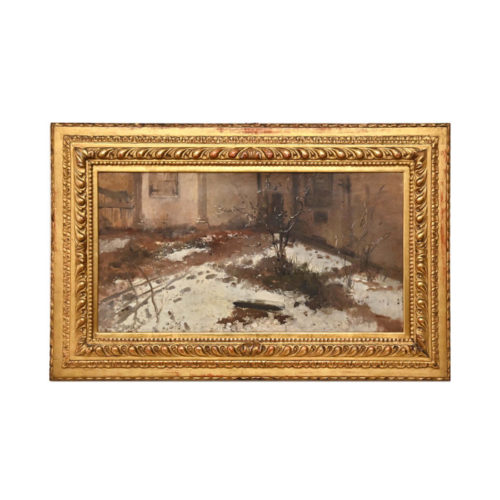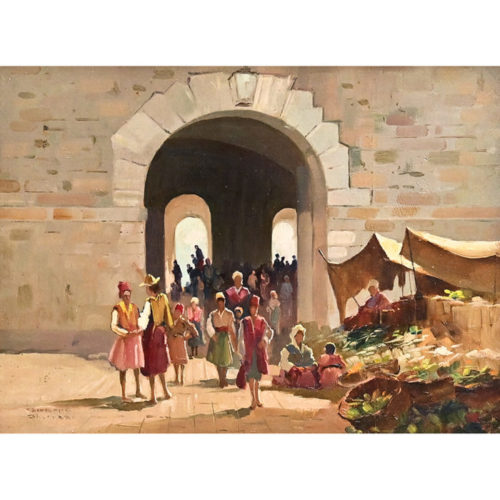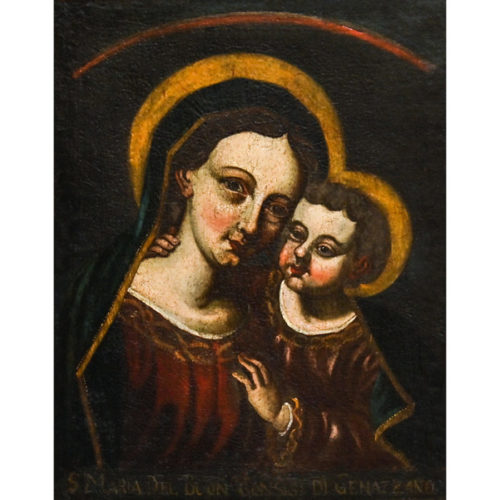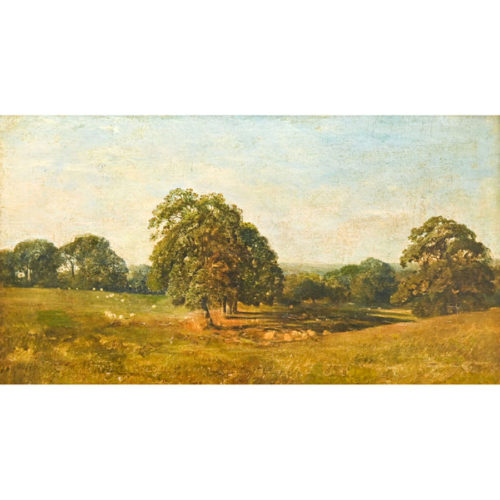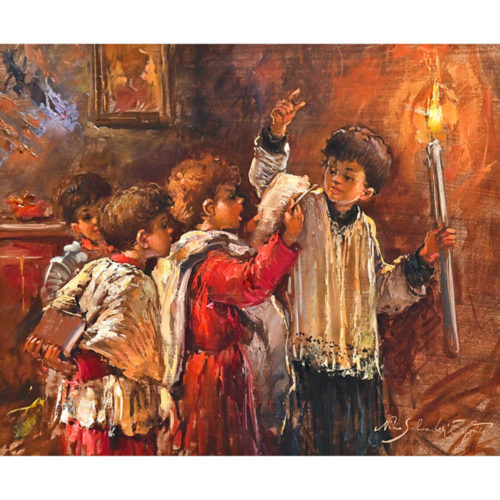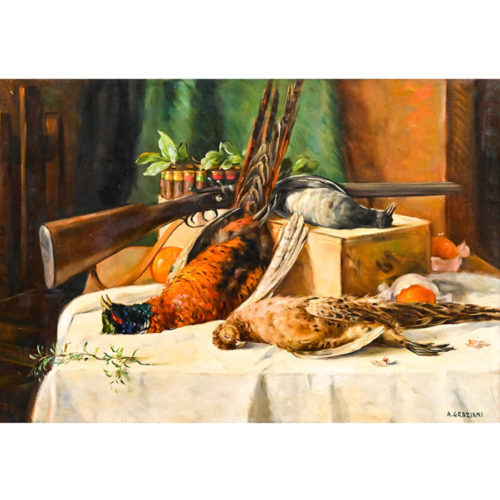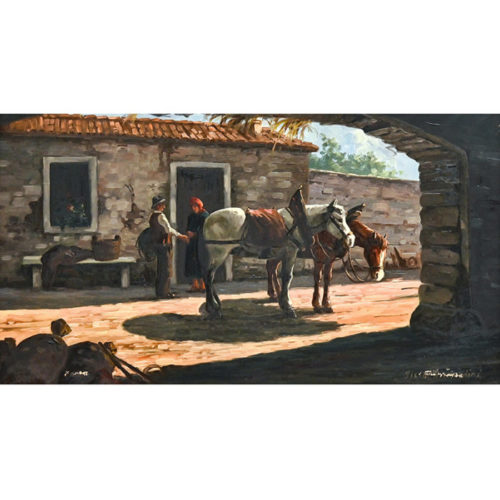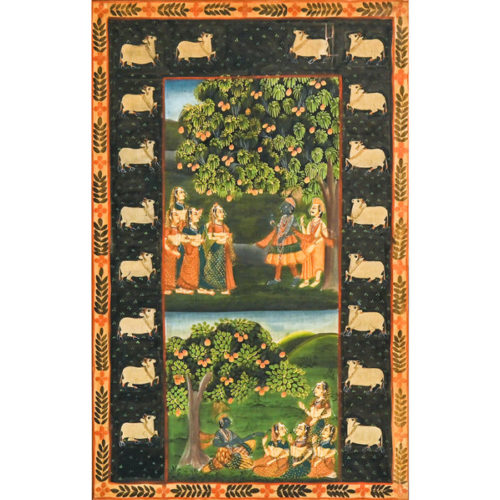-
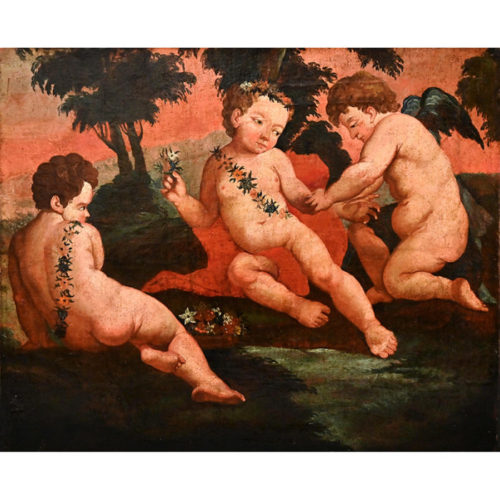 "Allegory of Spring", play of Putti with flowers and flower necklaces, oil on canvas from the first half of the 18th century, Italian school. Re-painting and restoration, gilded frame not contemporary. Period: First half of the 18th century Measurements: Framed H 73.5 x W 86.5 x D 4 / Canvas H 60x W 73.5 cm
"Allegory of Spring", play of Putti with flowers and flower necklaces, oil on canvas from the first half of the 18th century, Italian school. Re-painting and restoration, gilded frame not contemporary. Period: First half of the 18th century Measurements: Framed H 73.5 x W 86.5 x D 4 / Canvas H 60x W 73.5 cm -
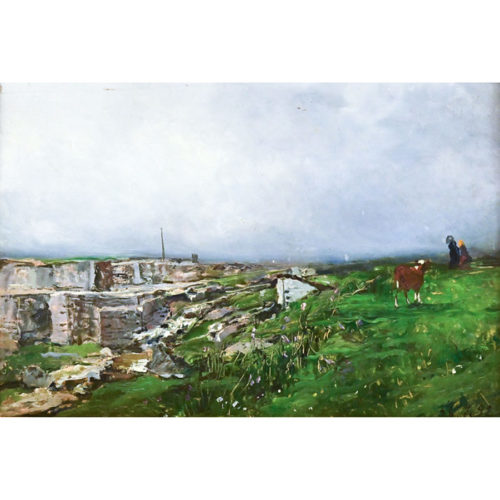 "Grey weather" oil on panel by Lorenzo Delleani. Original work by the artist from Biella, oil on panel 31 x 45 cm, with authentication by Bistolfi on the back and confirmation from the Archivio Pittori e Scultori Piemontesi. The painting depicts one of the frequent grey days of fog and rain around the Sanctuary of Oropa, more precisely in the meadow above the Sanctuary, where twenty years later the construction of the New Basilica of Oropa began. Period: 29/7/92 Measurements: In frame H 51,5 x W 65,5 x D 6,5 / Tablet H 31 x 45 cm
"Grey weather" oil on panel by Lorenzo Delleani. Original work by the artist from Biella, oil on panel 31 x 45 cm, with authentication by Bistolfi on the back and confirmation from the Archivio Pittori e Scultori Piemontesi. The painting depicts one of the frequent grey days of fog and rain around the Sanctuary of Oropa, more precisely in the meadow above the Sanctuary, where twenty years later the construction of the New Basilica of Oropa began. Period: 29/7/92 Measurements: In frame H 51,5 x W 65,5 x D 6,5 / Tablet H 31 x 45 cm -
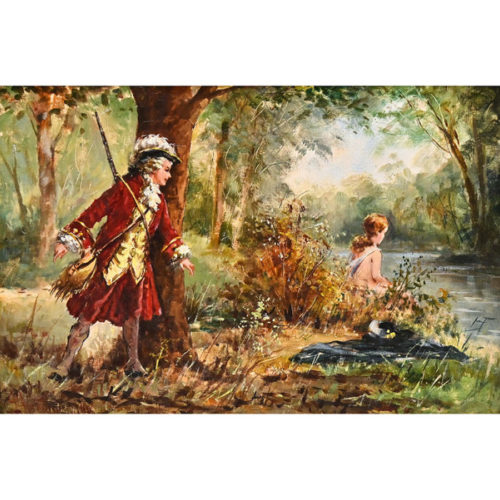 Oil on panel by Aldo Affortunati, dating from the 1940s. Aldo Affortunati (Castenuovo di Garfagnana 1906 - 1991), lived in Florence. He began to paint Tuscan landscapes, obtained according to the spirit and technique of the 'macchiaioli'. He abandoned the paintbrush and took up the mestichino (small spatula) with which, by throwing the colours in masses onto the canvas, without spreading them, he obtained greater brilliance. His works are included in collections in the United States, Brazil, Switzerland, France, Germany and Belgium. His exhibition in New York was very successful. He held personal exhibitions in Rome, Bologna, Biella, Florence, Milan, Turin, New York, etc. Period: 1940s Measurements: In frame H 38 x W 48 x D 4 cm / Table H 20 x W 29.5 cm
Oil on panel by Aldo Affortunati, dating from the 1940s. Aldo Affortunati (Castenuovo di Garfagnana 1906 - 1991), lived in Florence. He began to paint Tuscan landscapes, obtained according to the spirit and technique of the 'macchiaioli'. He abandoned the paintbrush and took up the mestichino (small spatula) with which, by throwing the colours in masses onto the canvas, without spreading them, he obtained greater brilliance. His works are included in collections in the United States, Brazil, Switzerland, France, Germany and Belgium. His exhibition in New York was very successful. He held personal exhibitions in Rome, Bologna, Biella, Florence, Milan, Turin, New York, etc. Period: 1940s Measurements: In frame H 38 x W 48 x D 4 cm / Table H 20 x W 29.5 cm -
 Oil on panel by Aldo Affortunati, dating from the 1940s. Aldo Affortunati (Castenuovo di Garfagnana 1906 - 1991), lived in Florence. He began to paint Tuscan landscapes, obtained according to the spirit and technique of the 'macchiaioli'. He abandoned the paintbrush and took up the mestichino (small spatula) with which, by throwing the colours in masses onto the canvas, without spreading them, he obtained greater brilliance. His works are included in collections in the United States, Brazil, Switzerland, France, Germany and Belgium. His exhibition in New York was very successful. He held personal exhibitions in Rome, Bologna, Biella, Florence, Milan, Turin, New York, etc. Period: 1940s Measurements: H 48 x W 38,5 x D 4 cm / Table H 30 x W 20 cm
Oil on panel by Aldo Affortunati, dating from the 1940s. Aldo Affortunati (Castenuovo di Garfagnana 1906 - 1991), lived in Florence. He began to paint Tuscan landscapes, obtained according to the spirit and technique of the 'macchiaioli'. He abandoned the paintbrush and took up the mestichino (small spatula) with which, by throwing the colours in masses onto the canvas, without spreading them, he obtained greater brilliance. His works are included in collections in the United States, Brazil, Switzerland, France, Germany and Belgium. His exhibition in New York was very successful. He held personal exhibitions in Rome, Bologna, Biella, Florence, Milan, Turin, New York, etc. Period: 1940s Measurements: H 48 x W 38,5 x D 4 cm / Table H 30 x W 20 cm -
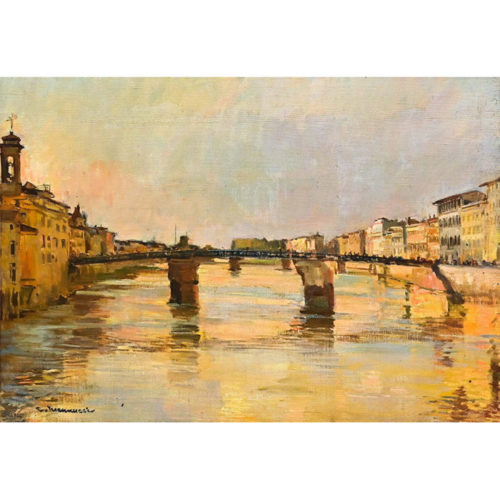 "Golden Light on the Arno' oil on canvas by Cipriano Antonio Mannucci (1882-1970). The work is from the 1940s. View of Florence from Ponte Vecchio, in the painting there are the 16th century Santa Trinità bridge, and the famous Basilica di Santo Spirito or Cappella del Brunelleschi on the left, while on the right the view is of the famous Lungarno degli Acciaiuoli. Period: 1940s Measurements: Framed H 74.5 x W 95 x D 8.5 / Canvas H 49.5 x W 70, 5 cm
"Golden Light on the Arno' oil on canvas by Cipriano Antonio Mannucci (1882-1970). The work is from the 1940s. View of Florence from Ponte Vecchio, in the painting there are the 16th century Santa Trinità bridge, and the famous Basilica di Santo Spirito or Cappella del Brunelleschi on the left, while on the right the view is of the famous Lungarno degli Acciaiuoli. Period: 1940s Measurements: Framed H 74.5 x W 95 x D 8.5 / Canvas H 49.5 x W 70, 5 cm -
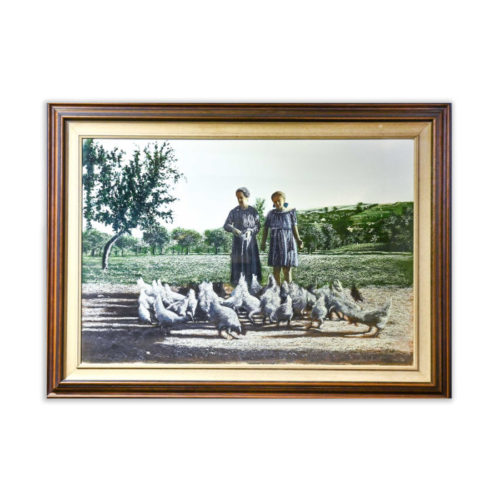 Scene of a courtyard, oil on cardboard by Daniele Fissore, signed and dated on lower right, a very rare work as the artist usually depicts the landscape without figures. Daniele Fissore (Savigliano 1947 - Savigliano 2017) began his artistic career as self-taught artist. In 1975 he took part in the X Quadriennale in Rome and in 1976 in the "Biennale del disegno" in Milan. A constant evolution of the first pictorial themes (see the "Telephone booths", the "Oppositions", the "Reconnaissance", investigated with an in-depth analysis of strong photographic inspiration), led him to the human figure and the portrait. Period: 1980 Measurements: Framed H 69 x W 93 x D 4,5 / Cardboard H 60 x W 84 cm
Scene of a courtyard, oil on cardboard by Daniele Fissore, signed and dated on lower right, a very rare work as the artist usually depicts the landscape without figures. Daniele Fissore (Savigliano 1947 - Savigliano 2017) began his artistic career as self-taught artist. In 1975 he took part in the X Quadriennale in Rome and in 1976 in the "Biennale del disegno" in Milan. A constant evolution of the first pictorial themes (see the "Telephone booths", the "Oppositions", the "Reconnaissance", investigated with an in-depth analysis of strong photographic inspiration), led him to the human figure and the portrait. Period: 1980 Measurements: Framed H 69 x W 93 x D 4,5 / Cardboard H 60 x W 84 cm -
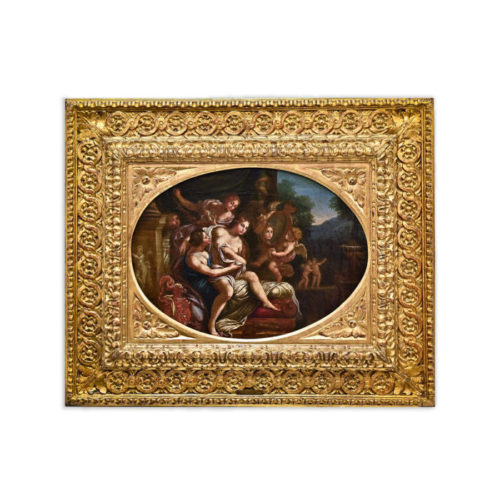 "Toilet of Venus" Oil on canvas first half of the 19th century with a very beautiful contemporary frame, gilded with gold leaf and carved. In the painting Venus is represented with her maidservants and cupids while she is intent on mirroring herself. The frame bears the name plate of the Bolognese painter Francesco Albani (1578-1660), the painting could be inspired by one of his works. Period: First half of the 19th century Measurements: Framed H 68 x W 81,5 x D 6,5 / Canvas H 40 x W 53 cm / Oval H 37 x W 50 cm
"Toilet of Venus" Oil on canvas first half of the 19th century with a very beautiful contemporary frame, gilded with gold leaf and carved. In the painting Venus is represented with her maidservants and cupids while she is intent on mirroring herself. The frame bears the name plate of the Bolognese painter Francesco Albani (1578-1660), the painting could be inspired by one of his works. Period: First half of the 19th century Measurements: Framed H 68 x W 81,5 x D 6,5 / Canvas H 40 x W 53 cm / Oval H 37 x W 50 cm -
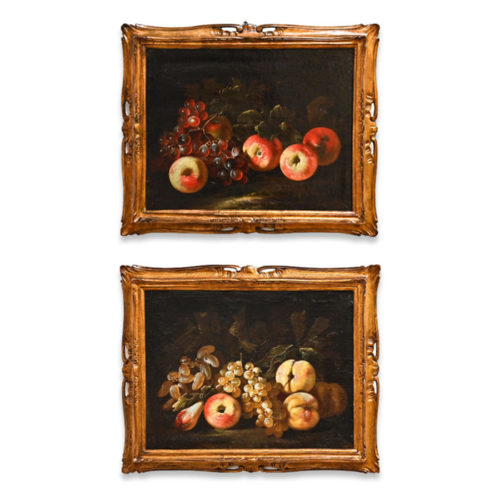 Bartolomeo Castelli known as Bartolomeo Spadino the Younger, pair of still lifes, oil on canvas. The paintings are accompanied by the authentication of Dr. Gianluca Bocchi. "Still life with grapes, apple, plum and two peaches placed on the ground", oil on canvas cm H 35.5 x L 46. "Still life with grapes and apples placed on the ground", oil on canvas cm H 35.5 x W 46. Bartolomeo Castelli the Younger (Rome 1696 - 1738), also known as Spadino for having derived the pseudonym of his father Giovanni Paolo, is the youngest member of a family of Roman artists dedicated to the representation of still lifes of fruit. The pictorial imprint found in his works does not seem to seek the Baroque inspiration visible in his father's canvases, more based on chromatic strength and the search for decorativeness, preferring to resume and successfully update the models of the homonymous uncle, called Bartolomeo for this reason Castelli the Elder. In one of these two small canvases there is a trace on the original frame of an inscription in eighteenth-century characters which can be distinguished with the word "Spadino". The identity of the writing, found on paintings with different origins, but characterized by the same style and the same subjects, confirms the originality of the signature that the author loved to affix on the back of his compositions, vaulted on the canvases or on the frames. The pair of canvases certainly belonged to a larger series that was dispersed or perhaps split up in the course of hereditary transmissions. The author had a predilection for small dimensions, where he knew how to best express his qualities as a fine investigator of nature, revisiting Campidogliesque modules learned with the study of his uncle's compositions, probably through the drawings and cartoons left by Bartolomeo the Elder in family. Period: 1720s / 1730s Measurements: H 35.5 x W 46 x D 3,5 cm
Bartolomeo Castelli known as Bartolomeo Spadino the Younger, pair of still lifes, oil on canvas. The paintings are accompanied by the authentication of Dr. Gianluca Bocchi. "Still life with grapes, apple, plum and two peaches placed on the ground", oil on canvas cm H 35.5 x L 46. "Still life with grapes and apples placed on the ground", oil on canvas cm H 35.5 x W 46. Bartolomeo Castelli the Younger (Rome 1696 - 1738), also known as Spadino for having derived the pseudonym of his father Giovanni Paolo, is the youngest member of a family of Roman artists dedicated to the representation of still lifes of fruit. The pictorial imprint found in his works does not seem to seek the Baroque inspiration visible in his father's canvases, more based on chromatic strength and the search for decorativeness, preferring to resume and successfully update the models of the homonymous uncle, called Bartolomeo for this reason Castelli the Elder. In one of these two small canvases there is a trace on the original frame of an inscription in eighteenth-century characters which can be distinguished with the word "Spadino". The identity of the writing, found on paintings with different origins, but characterized by the same style and the same subjects, confirms the originality of the signature that the author loved to affix on the back of his compositions, vaulted on the canvases or on the frames. The pair of canvases certainly belonged to a larger series that was dispersed or perhaps split up in the course of hereditary transmissions. The author had a predilection for small dimensions, where he knew how to best express his qualities as a fine investigator of nature, revisiting Campidogliesque modules learned with the study of his uncle's compositions, probably through the drawings and cartoons left by Bartolomeo the Elder in family. Period: 1720s / 1730s Measurements: H 35.5 x W 46 x D 3,5 cm -
 "Crucifixion" oil on canvas of the '600 /' 700. The canvas depicts the moment of Christ's Crucifixion, who is enveloped in the darkness of the solar eclipse. The body that emerges from the darkness, wrapped in such brightness that contrasts with the darkness of the background contributes to the highly dramatic rendering of the whole scene. "It was about noon, when the sun went out and darkened all over the earth until three in the afternoon. The veil of the temple was torn in the middle. Jesus, shouting in a loud voice, said:" Father, into your hands I deliver thee my spirit. '' (Luke 23, 44-45). Period: '600 /' 700 Measurements: H 81.5 x W 57.5 x D 2 cm
"Crucifixion" oil on canvas of the '600 /' 700. The canvas depicts the moment of Christ's Crucifixion, who is enveloped in the darkness of the solar eclipse. The body that emerges from the darkness, wrapped in such brightness that contrasts with the darkness of the background contributes to the highly dramatic rendering of the whole scene. "It was about noon, when the sun went out and darkened all over the earth until three in the afternoon. The veil of the temple was torn in the middle. Jesus, shouting in a loud voice, said:" Father, into your hands I deliver thee my spirit. '' (Luke 23, 44-45). Period: '600 /' 700 Measurements: H 81.5 x W 57.5 x D 2 cm -
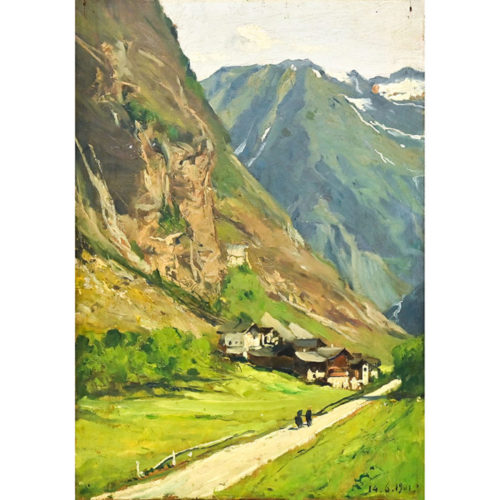 Valsesia surroundings of Carcoforo, Monte Rosa Oil on canvas by Lorenzo Delleani (Pollone 1840 – Torino 1908). Painting depicting the Valsesia near Carcoforo, dated 14 June 1901, with original Delleani frame. Stamp and authentication of Bistolfi on the back. Period: 14/06/1901 Measurements: In frame H 69.5 x W 57.5 x D 6.5 / Tablet H 44.5 x W 31.5 cm
Valsesia surroundings of Carcoforo, Monte Rosa Oil on canvas by Lorenzo Delleani (Pollone 1840 – Torino 1908). Painting depicting the Valsesia near Carcoforo, dated 14 June 1901, with original Delleani frame. Stamp and authentication of Bistolfi on the back. Period: 14/06/1901 Measurements: In frame H 69.5 x W 57.5 x D 6.5 / Tablet H 44.5 x W 31.5 cm -
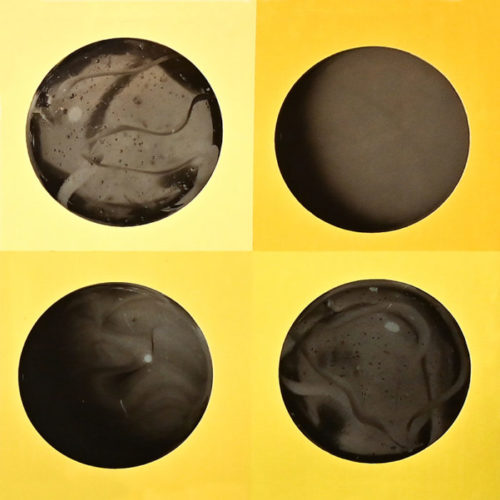 Mixed technique, enamels on aluminum by Marco Mazzucconi, 1988. Born in Milan in 1963, Marco Mazzucconi has exhibited in prestigious galleries such as Studio Marconi in Milan (1987) and Massimo Minini in Brescia (1985). In 2000 he returns to perform at Massimo Minini with his personal "Safe Zero". In 2017 he took part in the collective "White Surfaces" at the "Primae Noctis" art gallery in Lugano. He currently lives and works in Milan. Period: 1988 Measurements: H 100 x W 100 x D 3 cm
Mixed technique, enamels on aluminum by Marco Mazzucconi, 1988. Born in Milan in 1963, Marco Mazzucconi has exhibited in prestigious galleries such as Studio Marconi in Milan (1987) and Massimo Minini in Brescia (1985). In 2000 he returns to perform at Massimo Minini with his personal "Safe Zero". In 2017 he took part in the collective "White Surfaces" at the "Primae Noctis" art gallery in Lugano. He currently lives and works in Milan. Period: 1988 Measurements: H 100 x W 100 x D 3 cm -
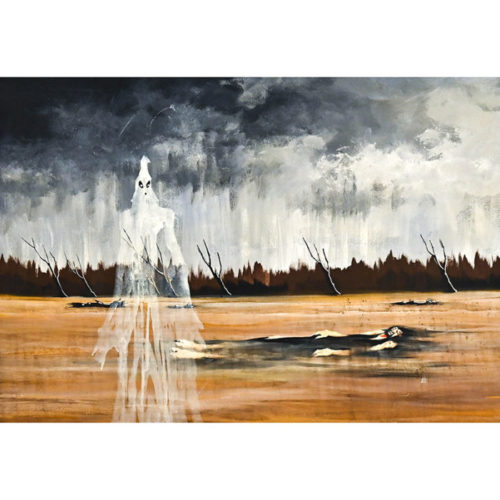 "I am Bonconte da Montefeltro ... So wounded at the top of the throat ..." Oil on canvas by Giancarlo Cori. Painted in 1984, the year in which he paints his last works. Confirmation of authenticity by his son Nicolò Cori. Period: 1984 Measurements: In frame H 84 x W 113.5 x D 3.5 / Canvas H 78 x 107.5 cm
"I am Bonconte da Montefeltro ... So wounded at the top of the throat ..." Oil on canvas by Giancarlo Cori. Painted in 1984, the year in which he paints his last works. Confirmation of authenticity by his son Nicolò Cori. Period: 1984 Measurements: In frame H 84 x W 113.5 x D 3.5 / Canvas H 78 x 107.5 cm -
 Oil on tablet, Luigi Locatelli. Painted tablet by Luigi Locatelli, depicting mother with child on a fence, signed lower right. No frame. Locatelli Luigi (known as Bigì) (Bergamo 1904-1983) after his first training with his father, he enrolled at the Carrara Academy. Before the age of twenty he starts working for the Milan gallery owner Zecchini. In the 1930s he moved to Paris where he became friends with the great Italian artists who lived in the French capital. After about ten years he returns to Italy settling in Bologna where he works as a restorer. Period: 1934 Measurements: H 41 x L 33 cm
Oil on tablet, Luigi Locatelli. Painted tablet by Luigi Locatelli, depicting mother with child on a fence, signed lower right. No frame. Locatelli Luigi (known as Bigì) (Bergamo 1904-1983) after his first training with his father, he enrolled at the Carrara Academy. Before the age of twenty he starts working for the Milan gallery owner Zecchini. In the 1930s he moved to Paris where he became friends with the great Italian artists who lived in the French capital. After about ten years he returns to Italy settling in Bologna where he works as a restorer. Period: 1934 Measurements: H 41 x L 33 cm -
 "San Grato Di Aosta with the head of the Baptist" oil on canvas from the first half of the 18th century. The work has been restored. An important legend flourished on the account of San Grato, now proven to be completely anachronistic, which goes by the name of Magna legenda Sancti Grati and is attributed to canon Jacques des Cours, who lived in the 13th century. The story of the discovery of the head of St. John the Baptist, a relic often associated with San Grato in popular iconography, dates back to this tradition. Beheaded by a whim of the beautiful Salome, the head of the Forerunner by order of King Herod Antipas was buried in a well separated from his body, for fear that he might miraculously rejoin it and John might rise again. Grato had a vision from the Lord, in which he was shown the secret location of the burial. He left Aosta in the company of his companion Giocondo, received the Pope's blessing in Rome and then embarked for the Holy Land. During the crossing, a great storm broke out, which threw terror among the sailors, but Grato, raised his arms to the sky, which instantly returned calm. When he arrived in Macheron, near the ruins of Herod's castle, an angel guided him, taking him by the hand and leading him to the well where the head of the Baptist had been for centuries. Immediately the relic rose to the surface and settled in Grato's outstretched palms. Period: First half of the 18th century Measurements: H 110.5 x W 97 x D 2 cm
"San Grato Di Aosta with the head of the Baptist" oil on canvas from the first half of the 18th century. The work has been restored. An important legend flourished on the account of San Grato, now proven to be completely anachronistic, which goes by the name of Magna legenda Sancti Grati and is attributed to canon Jacques des Cours, who lived in the 13th century. The story of the discovery of the head of St. John the Baptist, a relic often associated with San Grato in popular iconography, dates back to this tradition. Beheaded by a whim of the beautiful Salome, the head of the Forerunner by order of King Herod Antipas was buried in a well separated from his body, for fear that he might miraculously rejoin it and John might rise again. Grato had a vision from the Lord, in which he was shown the secret location of the burial. He left Aosta in the company of his companion Giocondo, received the Pope's blessing in Rome and then embarked for the Holy Land. During the crossing, a great storm broke out, which threw terror among the sailors, but Grato, raised his arms to the sky, which instantly returned calm. When he arrived in Macheron, near the ruins of Herod's castle, an angel guided him, taking him by the hand and leading him to the well where the head of the Baptist had been for centuries. Immediately the relic rose to the surface and settled in Grato's outstretched palms. Period: First half of the 18th century Measurements: H 110.5 x W 97 x D 2 cm -
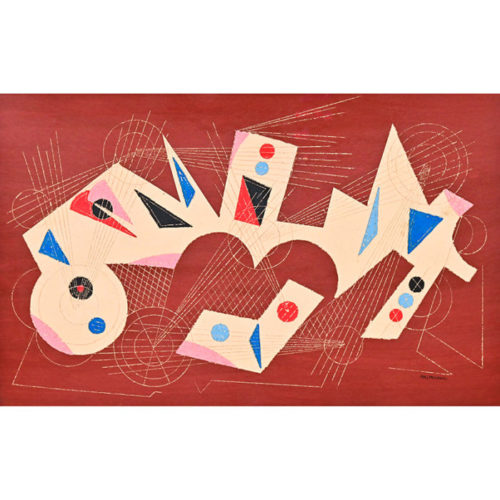 "Composition" by Umberto Mastroianni (Fontana Liri 1910 - Marino 1998), mixed technique / cardboard signed on the lower right, work number 0019. Authentication of the artist on photo. Umberto Mastroianni was born in Fontana Liri, in the province of Frosinone, on 21 September 1910. After his studies at the Academy of San Marcello in Rome, he moved with his family to Turin, continuing his training under the guidance of the master Guerrisi. His first works have a futurist imprinting; in particular he will be influenced by the works of Boccioni which Mastroianni tinges with neo-Cubism. The artist will be the founder of the Turin Prize in 1947 and, during his life, will receive important awards such as the International Grand Prize for Sculpture (Venice Biennale 1958) and the Tokyo Imperial Prize (1989). World famous artist, Umberto Mastroianni died on February 25, 1998 in his house-museum in Marino (Rome), leaving many masterpieces to posterity. Measurements: In frame H 77.5 x W 93.5 cm x D 5.5 / Canvas H 48.5 x W 65.5 cm
"Composition" by Umberto Mastroianni (Fontana Liri 1910 - Marino 1998), mixed technique / cardboard signed on the lower right, work number 0019. Authentication of the artist on photo. Umberto Mastroianni was born in Fontana Liri, in the province of Frosinone, on 21 September 1910. After his studies at the Academy of San Marcello in Rome, he moved with his family to Turin, continuing his training under the guidance of the master Guerrisi. His first works have a futurist imprinting; in particular he will be influenced by the works of Boccioni which Mastroianni tinges with neo-Cubism. The artist will be the founder of the Turin Prize in 1947 and, during his life, will receive important awards such as the International Grand Prize for Sculpture (Venice Biennale 1958) and the Tokyo Imperial Prize (1989). World famous artist, Umberto Mastroianni died on February 25, 1998 in his house-museum in Marino (Rome), leaving many masterpieces to posterity. Measurements: In frame H 77.5 x W 93.5 cm x D 5.5 / Canvas H 48.5 x W 65.5 cm -
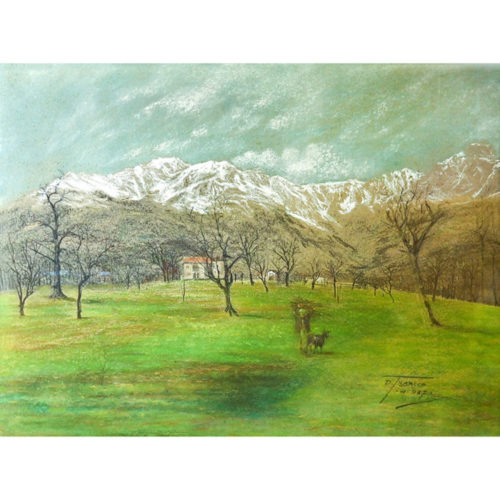 "Biella mountains seen from the Campra plateau" (Graglia) pastel on cardboard by Demetrio Tabacco. Work of March 1937, signed and dated on the lower right. Demetrio Tabacco (Turin 1886 -?) spent some time in the studio of Tommaso Ruffo in Turin. He made his debut in Biella in 1921; he later exhibited his works in Turin, Vercelli, Novara and Tripoli. In this last city he had lived from 1916 to 1918, faithfully portraying types and aspects of environment and manners. He treated landscapes, but he preferred depicting figures. Period: March 1937 Measurements: In frame H 77.5 x W 93.5 cm x D 5.5 / Canvas H 48.5 x W 65.5 cm
"Biella mountains seen from the Campra plateau" (Graglia) pastel on cardboard by Demetrio Tabacco. Work of March 1937, signed and dated on the lower right. Demetrio Tabacco (Turin 1886 -?) spent some time in the studio of Tommaso Ruffo in Turin. He made his debut in Biella in 1921; he later exhibited his works in Turin, Vercelli, Novara and Tripoli. In this last city he had lived from 1916 to 1918, faithfully portraying types and aspects of environment and manners. He treated landscapes, but he preferred depicting figures. Period: March 1937 Measurements: In frame H 77.5 x W 93.5 cm x D 5.5 / Canvas H 48.5 x W 65.5 cm -
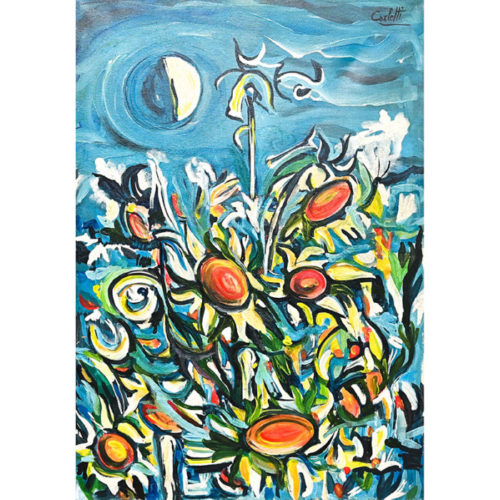 "Flowers and Moon" Oil on canvas by Mario Carletti from the 60s / 70s. Carletti Mario (Turin 1912 - Cossato 1977), a Piedmontese painter and engraver, he painted views, landscapes, portraits and works of sacred art. He exhibited at the Venice Biennale in 1942 and at the Rome Quadriennale in 1956. Period: 60s / 70s Measurements: H 100 x W 70 x D 2 cm
"Flowers and Moon" Oil on canvas by Mario Carletti from the 60s / 70s. Carletti Mario (Turin 1912 - Cossato 1977), a Piedmontese painter and engraver, he painted views, landscapes, portraits and works of sacred art. He exhibited at the Venice Biennale in 1942 and at the Rome Quadriennale in 1956. Period: 60s / 70s Measurements: H 100 x W 70 x D 2 cm -
Out of stock
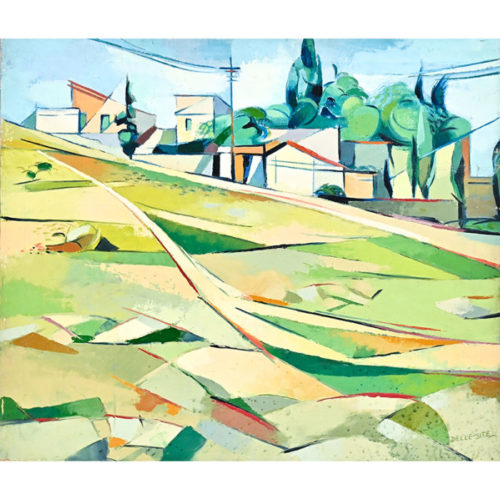 "Landscape on the Via Cassia" oil on canvas by Mino Delle Site. The work is signed at the bottom right Delle Site, listed in the catalog of the IV exhibition of figurative arts of Rome and Lazio, 1963, Galleria SPQR. On the back it has the gallery label. Mino Delle Site (Lecce 1914 - Rome 1996) had first studied in his city and then graduated from the Academy of Fine Arts in Rome. He took part to the Futurist Movement, from which he later broke away in search of new aesthetic expressions. He participated in the First Biennial of Palermo, the Second and Third Quadiennials of Rome and the Venice Biennials of 1934, 1936, 1938. In 1956 he presented in Rome an anthological exhibition summarizing twenty-five years of artistic activity; in 1957 he set up another solo exhibition in Rome, at the Aliberti Gallery; and he also participates in the VI, VII and VIII Roman Quadrennial. In 1965 he exhibited in the USA, at the Rizzoli Gallery in New York with a personal anthological exhibition, works from 1932 to 1965. He won numerous competitions and prizes: in 1936 a prize for Mural Painting; in 1946 a prize for the Female Nude; in 1950 a "Attic" award. He has made decorations and mosaics for public and private entities. His works can be found in both Italian and foreigner public and private collections. Period: 1963 Measurements: H 55 x W 65 x D 1.5 cm
"Landscape on the Via Cassia" oil on canvas by Mino Delle Site. The work is signed at the bottom right Delle Site, listed in the catalog of the IV exhibition of figurative arts of Rome and Lazio, 1963, Galleria SPQR. On the back it has the gallery label. Mino Delle Site (Lecce 1914 - Rome 1996) had first studied in his city and then graduated from the Academy of Fine Arts in Rome. He took part to the Futurist Movement, from which he later broke away in search of new aesthetic expressions. He participated in the First Biennial of Palermo, the Second and Third Quadiennials of Rome and the Venice Biennials of 1934, 1936, 1938. In 1956 he presented in Rome an anthological exhibition summarizing twenty-five years of artistic activity; in 1957 he set up another solo exhibition in Rome, at the Aliberti Gallery; and he also participates in the VI, VII and VIII Roman Quadrennial. In 1965 he exhibited in the USA, at the Rizzoli Gallery in New York with a personal anthological exhibition, works from 1932 to 1965. He won numerous competitions and prizes: in 1936 a prize for Mural Painting; in 1946 a prize for the Female Nude; in 1950 a "Attic" award. He has made decorations and mosaics for public and private entities. His works can be found in both Italian and foreigner public and private collections. Period: 1963 Measurements: H 55 x W 65 x D 1.5 cm -
 "Women in Piazza di Spagna, at the Fontana della Barcaccia, Rome" oil on canvas by the French painter François Maurice Roganeau. Work signed and dated F. M. Roganeau Rome 1908. Francis Maurice Roganeau (Bordeaux 1883 - Aix-en-Provence 1973) is a French painter, illustrator and sculptor. François-Maurice Roganeau was student of the renowned sculptors Gaston Veuvenot Leroux and Paul Quinsac at the School of Fine Arts in Bordeaux, then he went to study in Jean-Léon Gérôme's studio and later on with Gabriel Ferrier at the Beaux-Arts in Paris. He started with illustration and painting. As an illustrator, he mainly worked for the publisher Henri Laurens. In 1906 he won the first Grand Prix of Rome in painting and the second Grand Prix of sculpture. He exhibited at the 1912 Salon and received a medal for his he painting Le Soir, à la Rivière, inspired by one of André Chénier's Poésies antiques. In 1917 he was commissioned to repair the identical ceiling of the Grand Théâtre de Bordeaux, initially painted by Jean-Baptiste-Claude Robin. He also supplied colored glass boxes to the master glassmaker Gustave Pierre Dagrant, such as the one in the stained glass window of the church of Castillon-la-Bataille. He was director of the Bordeaux School of Fine Arts from 1929 to 1958. In 1932 he was made a Knight of the Legion of Honor. His latest works depict the Basque Country, its people and its landscapes. Period: 1908 Measurements: In frame h 54.5 x L 61.5 x D 6 / Canvas 28.5 x L 35.5 cm
"Women in Piazza di Spagna, at the Fontana della Barcaccia, Rome" oil on canvas by the French painter François Maurice Roganeau. Work signed and dated F. M. Roganeau Rome 1908. Francis Maurice Roganeau (Bordeaux 1883 - Aix-en-Provence 1973) is a French painter, illustrator and sculptor. François-Maurice Roganeau was student of the renowned sculptors Gaston Veuvenot Leroux and Paul Quinsac at the School of Fine Arts in Bordeaux, then he went to study in Jean-Léon Gérôme's studio and later on with Gabriel Ferrier at the Beaux-Arts in Paris. He started with illustration and painting. As an illustrator, he mainly worked for the publisher Henri Laurens. In 1906 he won the first Grand Prix of Rome in painting and the second Grand Prix of sculpture. He exhibited at the 1912 Salon and received a medal for his he painting Le Soir, à la Rivière, inspired by one of André Chénier's Poésies antiques. In 1917 he was commissioned to repair the identical ceiling of the Grand Théâtre de Bordeaux, initially painted by Jean-Baptiste-Claude Robin. He also supplied colored glass boxes to the master glassmaker Gustave Pierre Dagrant, such as the one in the stained glass window of the church of Castillon-la-Bataille. He was director of the Bordeaux School of Fine Arts from 1929 to 1958. In 1932 he was made a Knight of the Legion of Honor. His latest works depict the Basque Country, its people and its landscapes. Period: 1908 Measurements: In frame h 54.5 x L 61.5 x D 6 / Canvas 28.5 x L 35.5 cm -
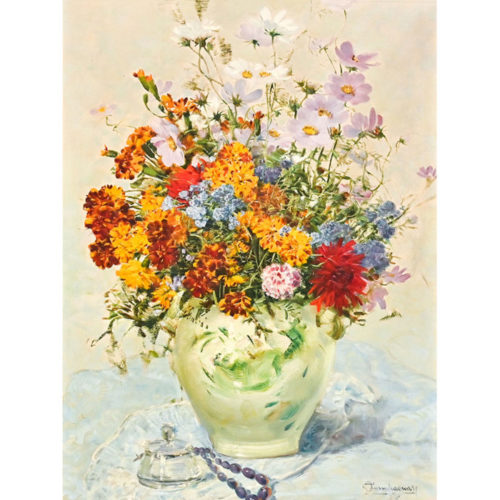 "Still life of flowers" oil on canvas from the 1950s by Ottorino Campagnari. Ottorino Campagnarini (Mestre 1910 - Turin 1987), studied painting at the art school in Mestre, under the professor Giuseppe Urbani. Settled in Turin in 1935, since 1940 he had exhibited regularly at the National Quadrennial of Art of the Promoter of Fine Arts in Turin, at the Gazzetta del Popolo cultural artist, at the Circolo degli Artisti in Turin. He also exhibited in group exhibitions: in Washington, Chicago, London, Turin, Naples, Milan, Rome etc. Personal exhibitions in Turin (Galleria Martina), Imperia, Milan (Galleria Bolzani), Valle d'Aosta, Gressoney-St. Jean (Palazzo Municipio) etc. He has had prizes in competitions and impromptu. Period: 1950s Measurements: In frame H 98 x W 77 x D 5.5 / Canvas H 80 x W 60 cm
"Still life of flowers" oil on canvas from the 1950s by Ottorino Campagnari. Ottorino Campagnarini (Mestre 1910 - Turin 1987), studied painting at the art school in Mestre, under the professor Giuseppe Urbani. Settled in Turin in 1935, since 1940 he had exhibited regularly at the National Quadrennial of Art of the Promoter of Fine Arts in Turin, at the Gazzetta del Popolo cultural artist, at the Circolo degli Artisti in Turin. He also exhibited in group exhibitions: in Washington, Chicago, London, Turin, Naples, Milan, Rome etc. Personal exhibitions in Turin (Galleria Martina), Imperia, Milan (Galleria Bolzani), Valle d'Aosta, Gressoney-St. Jean (Palazzo Municipio) etc. He has had prizes in competitions and impromptu. Period: 1950s Measurements: In frame H 98 x W 77 x D 5.5 / Canvas H 80 x W 60 cm -
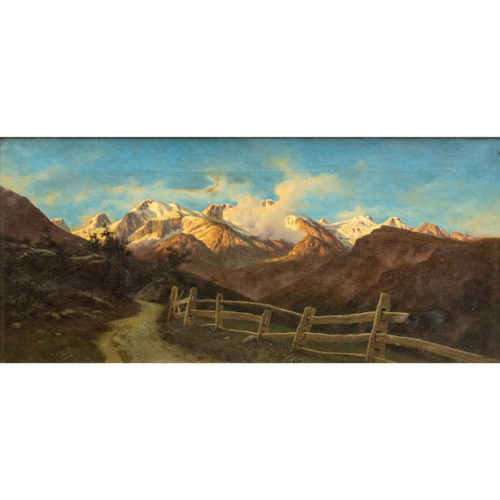 "Val d'Ayas" oil on canvas by Silvio Allason (1843-1912), signed and dated S.Allason 1909 lower left, in excellent condition. Silvio Allason (Turin 1845 - 1912), was first employed in the Ministry of War, but from around 1867 he devoted himself only to painting. After a stay in Florence, he was a pupil in Turin, at the Accademia Albertina, of E. Gamba and A. Gastaldi for the figure, studying however, at the same time, landscape with his cousin Ernesto and, upon his death, with E. Perotti . He began exhibiting at the Turin Promoter in 1869; in 1873 he had a notable success with the painting "In ambuato"; in 1876 he exhibited "The rescue". He made a specialty of the effects of moonshine with figures. He also exhibited in Milan, Naples, Paris (Salon of 1878), Nice, where one of his paintings "Among the rocks" was purchased for the Chéret Museum. Other works of his are in the Civic Museum of Turin. But an unknown title of Allison in landscape art is given by an infinity of studies from life, which he almost never showed, rich in superior elements, such as the wisdom and taste of composition, heroically patient drawing, simply effective technique and excellent color. Period: 1909 Measurements: In frame H 68 x W 128.5 x D 5.5 / Canvas H 52 x W 112.5 cm
"Val d'Ayas" oil on canvas by Silvio Allason (1843-1912), signed and dated S.Allason 1909 lower left, in excellent condition. Silvio Allason (Turin 1845 - 1912), was first employed in the Ministry of War, but from around 1867 he devoted himself only to painting. After a stay in Florence, he was a pupil in Turin, at the Accademia Albertina, of E. Gamba and A. Gastaldi for the figure, studying however, at the same time, landscape with his cousin Ernesto and, upon his death, with E. Perotti . He began exhibiting at the Turin Promoter in 1869; in 1873 he had a notable success with the painting "In ambuato"; in 1876 he exhibited "The rescue". He made a specialty of the effects of moonshine with figures. He also exhibited in Milan, Naples, Paris (Salon of 1878), Nice, where one of his paintings "Among the rocks" was purchased for the Chéret Museum. Other works of his are in the Civic Museum of Turin. But an unknown title of Allison in landscape art is given by an infinity of studies from life, which he almost never showed, rich in superior elements, such as the wisdom and taste of composition, heroically patient drawing, simply effective technique and excellent color. Period: 1909 Measurements: In frame H 68 x W 128.5 x D 5.5 / Canvas H 52 x W 112.5 cm -
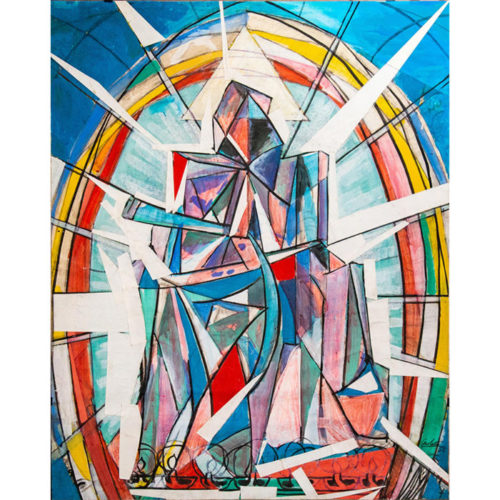 Artwork in mixed technique by Mario Carletti, dated 1962. Acrylic and collage on canvas. Carletti Mario (Turin 1912 - Cossato 1977), a Piedmontese painter and engraver, he painted views, landscapes, portraits and also works of sacred art. He exhibited at the Venice Biennale in 1942 and at the Rome Quadriennale in 1956. Period: 1962 Measurements: H 101 x W 81 x D 2 cm
Artwork in mixed technique by Mario Carletti, dated 1962. Acrylic and collage on canvas. Carletti Mario (Turin 1912 - Cossato 1977), a Piedmontese painter and engraver, he painted views, landscapes, portraits and also works of sacred art. He exhibited at the Venice Biennale in 1942 and at the Rome Quadriennale in 1956. Period: 1962 Measurements: H 101 x W 81 x D 2 cm -
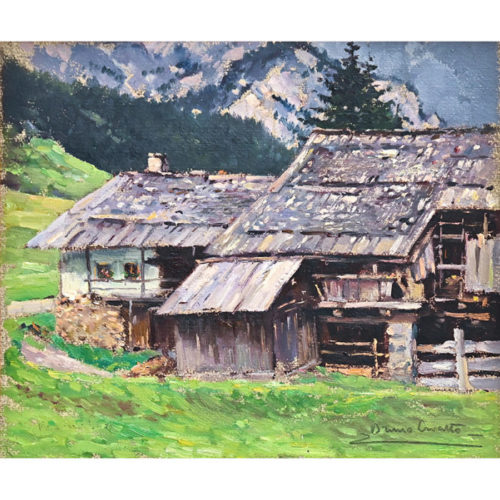 "Fontanazzo in Val di Fassa, Trentino" by Bruno Croatto (1875-1948), oil on cardboard signed on the lower right and titled on the back. Without frame. He was born in Trieste on April 12th, 1875. In the years 1891-1892 he was a disciple of Gabriel Hackl at the Academy of Munich: but he studied the Impressionists outside school, and eventually the great masters of the fifteenth century. He worked on figures, landscapes, flowers, but from 1908 he emerged in etching and aquatint, in which, neglecting the drawing, he sought only colorist effects and chiaroscuro. He exhibited in Munich, Trieste, Paris, Venice, Rome, Milan, London, Prague, Vienna. In 1930 he held a solo exhibition at the Chamber of Artists in Rome, with many paintings and etchings. Some of his works are kept in the Uffizi Gallery; at the Revoltella Museum in Trieste; in public collections in New York and in England. Period: early 1900s Measurements: H 28 X L 33 cm
"Fontanazzo in Val di Fassa, Trentino" by Bruno Croatto (1875-1948), oil on cardboard signed on the lower right and titled on the back. Without frame. He was born in Trieste on April 12th, 1875. In the years 1891-1892 he was a disciple of Gabriel Hackl at the Academy of Munich: but he studied the Impressionists outside school, and eventually the great masters of the fifteenth century. He worked on figures, landscapes, flowers, but from 1908 he emerged in etching and aquatint, in which, neglecting the drawing, he sought only colorist effects and chiaroscuro. He exhibited in Munich, Trieste, Paris, Venice, Rome, Milan, London, Prague, Vienna. In 1930 he held a solo exhibition at the Chamber of Artists in Rome, with many paintings and etchings. Some of his works are kept in the Uffizi Gallery; at the Revoltella Museum in Trieste; in public collections in New York and in England. Period: early 1900s Measurements: H 28 X L 33 cm -
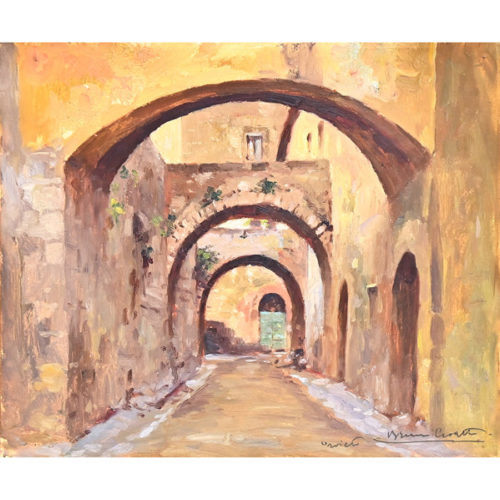 "Via delle Scalette in Orvieto" by Bruno Croatto (1875-1948), oil on cardboard signed on the lower right and titled on the back. Without frame. He was born in Trieste on April 12, 1875. In the years 1891-1892 he was a disciple of Gabriel Hackl at the Academy of Munich: but he studied the Impressionists outside school, and eventually the great masters of the fifteenth century. He dealt with the figure, the landscape, the flowers, but from 1908 he emerged in etching and aquatint, in which, neglecting the drawing, he sought only effects of color and chiaroscuro. He exhibited in Munich, Trieste, Paris, Venice, Rome, Milan, London, Prague, Vienna. In 1930 he held a personal exhibition at the Chamber of Artists in Rome, with many paintings and etchings. Some of his works are kept in the Uffizi Gallery; at the Revoltella Museum in Trieste; in public collections of New York and England. Period: 1930s / 40s Measurements: H 28 X L 33 cm
"Via delle Scalette in Orvieto" by Bruno Croatto (1875-1948), oil on cardboard signed on the lower right and titled on the back. Without frame. He was born in Trieste on April 12, 1875. In the years 1891-1892 he was a disciple of Gabriel Hackl at the Academy of Munich: but he studied the Impressionists outside school, and eventually the great masters of the fifteenth century. He dealt with the figure, the landscape, the flowers, but from 1908 he emerged in etching and aquatint, in which, neglecting the drawing, he sought only effects of color and chiaroscuro. He exhibited in Munich, Trieste, Paris, Venice, Rome, Milan, London, Prague, Vienna. In 1930 he held a personal exhibition at the Chamber of Artists in Rome, with many paintings and etchings. Some of his works are kept in the Uffizi Gallery; at the Revoltella Museum in Trieste; in public collections of New York and England. Period: 1930s / 40s Measurements: H 28 X L 33 cm -
Out of stock
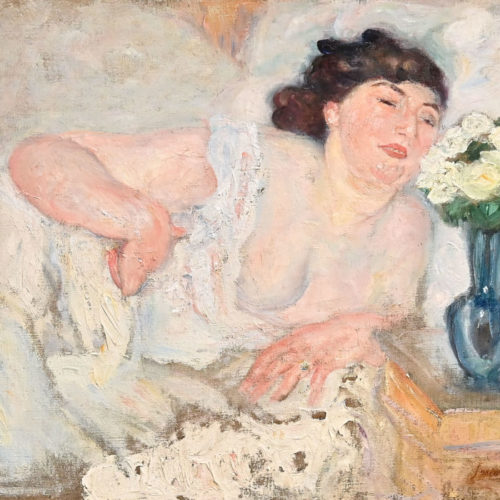 "Woman lying with blue vase" by Armando Spadini, oil on canvas signed on the lower right and dated 1902 on the back. The painting, although in excellent condition, needs cleaning. Armando Spadini (Poggio Caiano 1883 - Rome 1925) studied at the Institute of Fine Arts in Florence for a short time, visiting museums and exhibitions on his own, and assimilating, with his sensitivity, the joyfullness of colours, which is expressed personally, but not too far from the Venetian and French painters. Precisely this great love for the festive colours, for the transparent clarity, for the solar luminosity is showed in all his works, without the tormenting research that often characterized the work of the Impressionists. He is a painter superior to his time, to his environment; Emilio Cecchi considers him, like Antonio Mancini, the strongest pictorial temperament that arose in Italy after the end of the 18th century. Having won the competition for national retirement for painting in Florence in 1910, he settled in Rome, where he remained until his death, keeping on painting. He participated, but not so often, in various Roman and Florentine exhibitions, and in 1918 he held a solo show at the Casina Valadier in Rome. In 1924 at the Venice Biennale he had a room, where only his works had been displayed. Many of his works are in public and private galleries in Italy, in Paris, in Buenos Aires, in Lima. At the VI Quadriennale in Rome, in 1952, a commemorative exhibition took place with eighteen works. His works were also present at the 1956 edition of the same event. Period: 1902 Measurements: In frame H 80 x W 94 x D 12 / Canvas H 53.5 x W 70.5 cm
"Woman lying with blue vase" by Armando Spadini, oil on canvas signed on the lower right and dated 1902 on the back. The painting, although in excellent condition, needs cleaning. Armando Spadini (Poggio Caiano 1883 - Rome 1925) studied at the Institute of Fine Arts in Florence for a short time, visiting museums and exhibitions on his own, and assimilating, with his sensitivity, the joyfullness of colours, which is expressed personally, but not too far from the Venetian and French painters. Precisely this great love for the festive colours, for the transparent clarity, for the solar luminosity is showed in all his works, without the tormenting research that often characterized the work of the Impressionists. He is a painter superior to his time, to his environment; Emilio Cecchi considers him, like Antonio Mancini, the strongest pictorial temperament that arose in Italy after the end of the 18th century. Having won the competition for national retirement for painting in Florence in 1910, he settled in Rome, where he remained until his death, keeping on painting. He participated, but not so often, in various Roman and Florentine exhibitions, and in 1918 he held a solo show at the Casina Valadier in Rome. In 1924 at the Venice Biennale he had a room, where only his works had been displayed. Many of his works are in public and private galleries in Italy, in Paris, in Buenos Aires, in Lima. At the VI Quadriennale in Rome, in 1952, a commemorative exhibition took place with eighteen works. His works were also present at the 1956 edition of the same event. Period: 1902 Measurements: In frame H 80 x W 94 x D 12 / Canvas H 53.5 x W 70.5 cm -
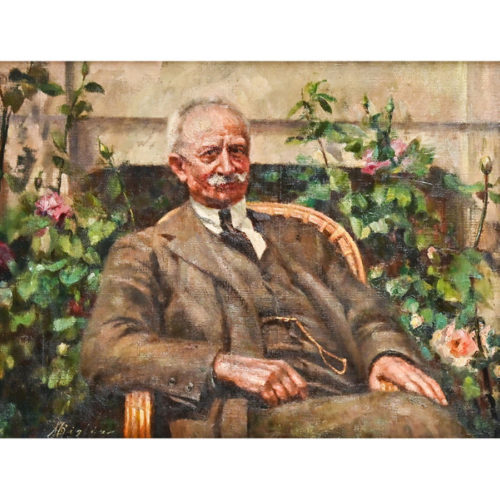 Large portrait oil on canvas, attributed to the painter Paolo Ghiglia (1905-1979), signed on the lower left, 1940s / 1950s. Paulo Ghiglia (Florence, March 5, 1905 - Rome, November 19, 1979) was an Italian painter. He starts painting very young with his father and teacher Oscar; at the age of twenty he leaves his father's house and moves to La Verna, where he lives for about five years. He made his debut in Milan in 1929 at the Pesaro Gallery with his father Oscar and his brother Valentino, also a painter. In 1931 he was at the first Quadriennale in Rome: thanks to Petrolini, his close friend, he was introduced to the capital city life and society, where his portraits period began. He stays in Paris where he portrays Joséphine Baker. He goes back to Rome, city that together with Florence, Livorno and La Verna, will be and remain the places and sources of greatest inspiration. In the forties and fifties his production focuses on portraits of illustrious people. His works can be found in various museums around the world, from the Uffizi, with two self-portraits, kept at the Metropolitan Museum of Art. Measurements: In frame H 80 x W 100 x D 10 / Canvas H 68 x W 87 cm
Large portrait oil on canvas, attributed to the painter Paolo Ghiglia (1905-1979), signed on the lower left, 1940s / 1950s. Paulo Ghiglia (Florence, March 5, 1905 - Rome, November 19, 1979) was an Italian painter. He starts painting very young with his father and teacher Oscar; at the age of twenty he leaves his father's house and moves to La Verna, where he lives for about five years. He made his debut in Milan in 1929 at the Pesaro Gallery with his father Oscar and his brother Valentino, also a painter. In 1931 he was at the first Quadriennale in Rome: thanks to Petrolini, his close friend, he was introduced to the capital city life and society, where his portraits period began. He stays in Paris where he portrays Joséphine Baker. He goes back to Rome, city that together with Florence, Livorno and La Verna, will be and remain the places and sources of greatest inspiration. In the forties and fifties his production focuses on portraits of illustrious people. His works can be found in various museums around the world, from the Uffizi, with two self-portraits, kept at the Metropolitan Museum of Art. Measurements: In frame H 80 x W 100 x D 10 / Canvas H 68 x W 87 cm -
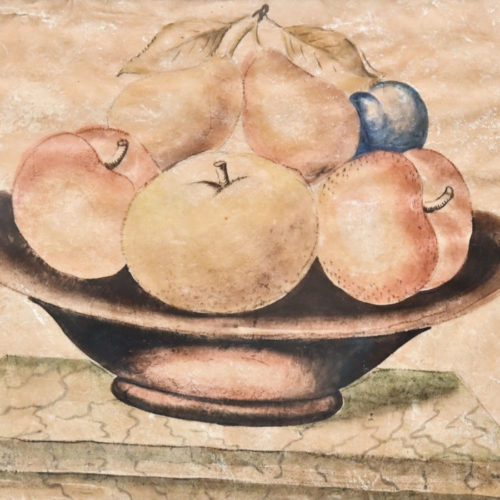 The painter Octavianus Monfort was known until 1990 only through a group of miniatures, signed and dated, depicting still lifes, which chronologically climbed between 1680 and 1689; and for a series of signed but undated miniatures, always depicting still lifes or, in some cases, sacred scenes. Period: 17th century Measurements: In frame H 28 x W 37.5 x D 2.5 / Parchment H23.5 x W 32.5 cm
The painter Octavianus Monfort was known until 1990 only through a group of miniatures, signed and dated, depicting still lifes, which chronologically climbed between 1680 and 1689; and for a series of signed but undated miniatures, always depicting still lifes or, in some cases, sacred scenes. Period: 17th century Measurements: In frame H 28 x W 37.5 x D 2.5 / Parchment H23.5 x W 32.5 cm -
 Watercolour on paper by Giulio Falzoni, signed on the lower right. Giulio Falzoni (Marmirolo, June 1st 1900 - Milano, 1978). In his youth he studied music and painting, specifically dedicating his work and research towards mural painting. In 1915 he started studying drawing in Mantova and the following year he worked as decorator. From 1928 to 1943 he stayed in Florence, where he attended the Academy of Fine Arts and developped his artistic skills under the lead of Plinio Nomellini. He started to stand out from his contemporary colleagues thanks to his watercolour technique, mastering it in London at the Royal Watercolour Society in the end of the 1940s. His first solo exhibition was set up in 1939 in Mantova, then Florence, Padova, Prato, Neaples, Venice and Milan followed. Some of his exhibitions have taken place in the United States of America, United Kingdom, France and Switzerland. Several prestigious collections see his works as their part, as for instance the Galleria degli Uffizi and Musei Capitolini. Measurements: In frame H56 x W49,5 x D4,5 // H32 x W26 cm.
Watercolour on paper by Giulio Falzoni, signed on the lower right. Giulio Falzoni (Marmirolo, June 1st 1900 - Milano, 1978). In his youth he studied music and painting, specifically dedicating his work and research towards mural painting. In 1915 he started studying drawing in Mantova and the following year he worked as decorator. From 1928 to 1943 he stayed in Florence, where he attended the Academy of Fine Arts and developped his artistic skills under the lead of Plinio Nomellini. He started to stand out from his contemporary colleagues thanks to his watercolour technique, mastering it in London at the Royal Watercolour Society in the end of the 1940s. His first solo exhibition was set up in 1939 in Mantova, then Florence, Padova, Prato, Neaples, Venice and Milan followed. Some of his exhibitions have taken place in the United States of America, United Kingdom, France and Switzerland. Several prestigious collections see his works as their part, as for instance the Galleria degli Uffizi and Musei Capitolini. Measurements: In frame H56 x W49,5 x D4,5 // H32 x W26 cm.
